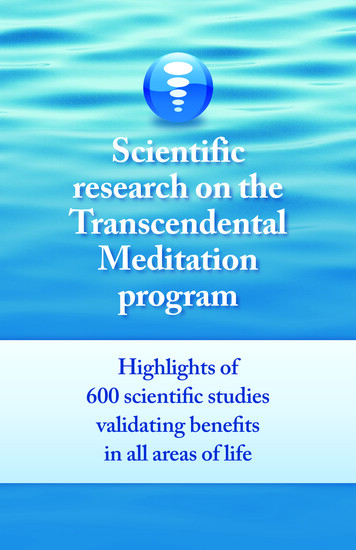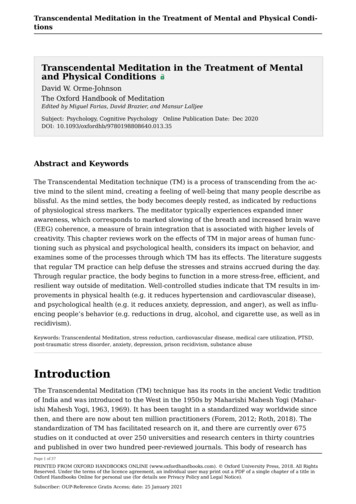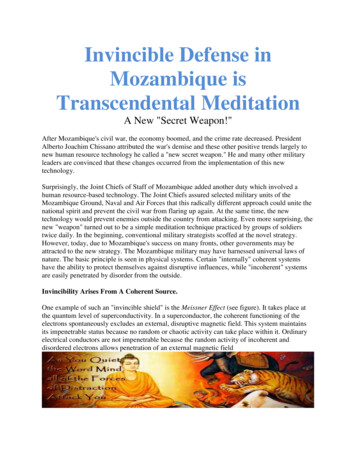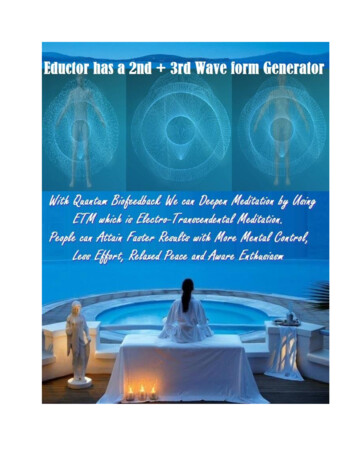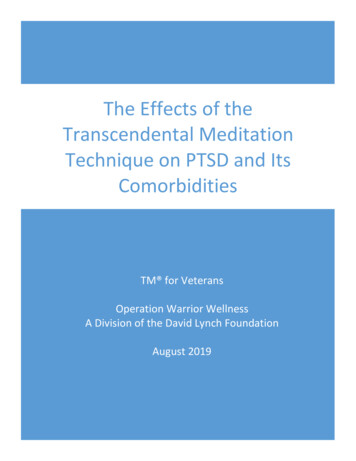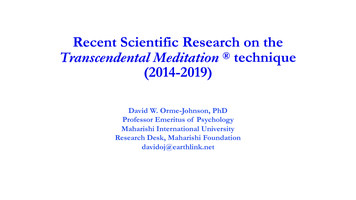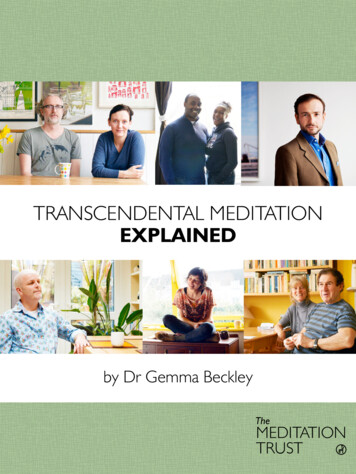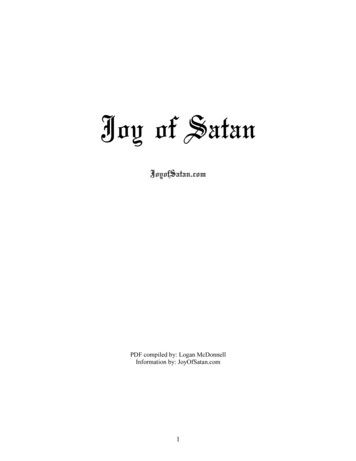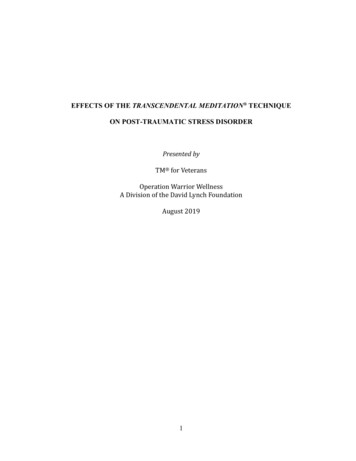
Transcription
EFFECTS OF THE TRANSCENDENTAL MEDITATION TECHNIQUEON POST-TRAUMATIC STRESS DISORDERPresented byTM for VeteransOperation Warrior WellnessA Division of the David Lynch FoundationAugust 20191
2019. David Lynch Foundation, a non-profit educational organization. All rights reserved. Transcendental Meditation and TM are protectedtrademarks and are used in the U.S. under license or with permission. 2019. Maharishi Foundation USA, Inc., a non-profit educational organization. All rights reserved. Transcendental Meditation and TM are protectedtrademarks and are used in the U.S. under license or with permission.2
The Effects of the Transcendental Meditation Technique on PTSDPost-Traumatic Stress Disorder (PTSD) is a serious and disabling condition that affects approximately 6%to 7% of adults in the U.S. over their lifespan.1 The incidence is at least two to three times greater inveterans and active-duty personnel who have seen combat.2-3 PTSD is associated with comorbidities, suchas major depression, substance abuse, suicide, and poor physical health.4-6 It is widely recognized thatcurrent pharmacological and psychotherapeutic approaches to treating PTSD are not fully adequatebecause of limitations in both effectiveness and acceptability to patients.7 As a consequence, there is anacknowledged need to identify new approaches to treating PTSD that are both effective and acceptable.Transcendental Meditation (TM) is a simple, natural, easily learned technique that is practiced twicedaily, sitting comfortably in a chair. It has been extensively researched and learned by millions ofAmericans. The TM technique is not a philosophy or a religion and requires no belief or change inlifestyle. The more than 420 peer-reviewed studies conducted on the technique over the last 50 yearshave demonstrated that it is effective at treating stress-related conditions, such as hypertension,anxiety, and depression, as well as enhancing mental and physical health and cognitive function.8,9Studies on physiological outcomes have shown that the effects of TM practice are opposite to thoseproduced by stress and the fight-or-flight response.10,11 Psychological research on TM indicates effectscounter to the twenty DSM-5 symptoms associated with PTSD.12-27 No adverse effects have beenreported in three published reviews of the TM research. 28-30The first study on the TM technique and PTSD, a randomized controlled pilot trial on Vietnam Warveterans conducted in the early 1980s, found significant improvement in PTSD symptoms and a rangeof comorbidities, including depression, anxiety, insomnia and alcohol use, compared to controlsundergoing individual psychotherapy. 31 In recent years, additional studies have been conducted,including a major study funded by the U.S. Department of Defense and published in The LancetPsychiatry.32 As of spring 2019, there are 14 studies on the effects of TM on PTSD symptoms: 11peer-reviewed and three nonpeer-reviewed studies. Nineof these are on veterans andactive military. Four studieswith veterans arerandomized controlled trials(RCTs) and two withcivilians are RCTs. All thestudies found that TMpractice had large effectsizes in reducing PTSDsymptoms. This finding wasconsistent across studydesign, PTSD population,Figure 1: Effect Sizes of Studies on the TM Technique andand researcherPTSD in Veteran Populationsaffiliations.30-34,42,73-75,88-92Note: Effect size in statistics provides a quantitative measure of themagnitude (or effect) of a treatment. An effect size of .2 isFigure 1 presents the withinconsidered small, .5 medium, and .8 or greater large.group effect sizes of the eightveteran studies for which effectsize was calculated.30-32,73-75,88,90 These effect sizes are comparable to those produced by Prolonged3
Exposure and Cognitive Processing Therapy reported by Steenkamp in her review of psychotherapyfor military-related PTSD (Cohen d range, 0.78-1.10).7The largest of the PTSD studies using theTM technique to date, Nidich (2018),32was a non-inferiority trial, designed toassess directly whether TM practice wasnon-inferior to Prolonged Exposure (PE),considered the “gold-standard” therapyfor treating PTSD. Both the TMtechnique and PE were compared to anactive Health Education (HE) treatment.The study randomly assigned 203veterans with clinical PTSD (CAPS score 45) to either the TranscendentalMeditation technique (N 68), PE (N 68),or HE (N 67). Each treatment provided12 sessions, 90 minutes each, over 12Figure 2: Comparison of TM, Prolongedweeks, and included daily home practice.Exposure and Health Education on PTSD andFigure 2 shows the results for PTSDDepressionsymptoms and depression. All 202eligible patients randomly assigned totreatment were included in the intent-to-treat analyses, regardless of treatment dropout or missingpost-test data. The study found that both TM practice and PE were significantly more effective thanHE. TM practice was significantly non-inferior to PE for CAPS (Clinician Assisted PTSD Scale),PCL-M (PTSD Checklist-Military, a paper and pencil instrument), and depression (PHQ-9) scoreswhen using baseline dependent score, number of PTSD medications, sex, and number of years sincedischarge from the armed forces as covariates (p 0.0002). Percentages of participants with clinicallysignificant improvement on the CAPS ( 10 point reduction) were TM 62%, PE 42%, and HE 32%.4
Speed of EffectWhile trauma-focused therapies have significant effects onreducing PTSD symptoms, these effects are most clearlyseen after the first month of treatment in standarddistributed formats for delivery. With the TM technique,effects for many people are experienced almostimmediately. Research has shown that TM practiceproduces clinically meaningful reductions in PTSD at 10days33 and two weeks.34 Nidich found that reduction inPTSD as measured by the PCL-M occurred more quicklywith the TM technique than with Prolonged Exposure (seeFigure 3).32Effectiveness of TM in Treating Comorbidities of PTSDApproximately 80% of individuals with PTSD meet criteriafor at least one other psychiatric diagnosis and a substantialnumber have three or more other psychiatric diagnoses.35,36Chief among these are depressive, substance abuse, andanxiety disorders.36 Sleep disorders are also veryFigure 3: Change in Interim andprevalent—75% of veterans surveyed by the Wounded3-Month Test ScoresWarrior Project in 2017 reported sleep problems.37A nonpsychiatric comorbidity of PTSD is increase in cardiovascular risk. Veterans with PTSD have 77-85%greater likelihood of developing high blood pressure than those without PTSD.38 These comorbiditiescompound the effects of PTSD, leading to greater disability, greater cost, and greater suffering. Alarge body of research, including with military populations, has demonstrated the effectiveness of theTM technique in treating these conditions, which strengthens the justification for including TMpractice as a first-line treatment for PTSD.Depression: A meta-analysis of thefive TM studies focused on combatveterans with PTSD that includeddepression as a dependent variableshows that TM practice has a largeaverage effect (-.96) on reducingdepression in this population (seeFigure 4). Randomized controlledtrials on other patient populationshave found that the TM techniquereduced depression in patients withchronic heart failure,39 ventricularhypertrophy,40 HIV,41 and in prisoninmates42 and pre-hypertensiveyoung adults.43 Controlled trials onthe general population have foundFigure 4: Effects of TM on Depression in Combat Veteransthat TM practice reduced depressionin business managers,44 Japanese industrial workers,45 high school students,46 and school teacherssuffering from burnout.475
Substance Use Disorder: In meta-analyses, the TM technique was more effective in reducing smoking,alcohol consumption, and illicit drug use than conventional programs, whether or not these werecombined with relaxation techniques.48 In a randomized controlled study of 118 chronic malealcoholics undergoing in-residence rehabilitation treatment, patients practicing TM for 18 monthsshowed significantly fewer drinking days than other groups, including patients receiving EEGneurotherapy and conventional addiction counseling.49 A recent study of patients in a residentialrehabilitation program for alcohol use disorder found that those who were closely adherent to twice-dailypractice of TM (recommended schedule) were significantly less likely than controls to resume any drinking(25% vs 59%) or heavy drinking (0% vs. 47%) post-discharge.50Anxiety: A meta-analysis of 146 independent outcomes compared the effects on psychosocial stress(anxiety) of all stress-reduction and relaxation techniques that had been reported in the scientificliterature. The TM technique had a moderate to large effect on reducing anxiety (ES .7) and reducedanxiety to a significantly greater extent than other forms of meditation, relaxation, or stylized rest.51,52A meta-analysis of 30 studies found that TM practice was more effective in reducing trait anxiety thanmindfulness or other meditation techniques.53, 54 Another meta-analysis of 16 randomized controlledtrials found TM practice to be especially effective in reducing anxiety in people with elevated anxiety,including prisoners, war veterans, and war refugees, with rapid reductions in anxiety within the firsttwo weeks of practice.55 A three-month randomized controlled study of secondary school teachersfound that TM practice significantly reduced perceived stress, depression and overall teacherburnout.56 Two months of regular TM practice significantly reduced perceived stress and mooddisturbance in family caregivers, including reductions in anxiety, depression, anger, confusion, andfatigue, and increase in spiritual well-being.57Sleep Disorders: A three-month randomized controlled trial found the TM technique improved sleepin war veterans with PTSD compared to psychotherapy.31 A controlled longitudinal study reportedimproved sleep as well as reduced hostility and decreased neuroticism in incarcerated offenders.58 Afive-month controlled study of 735 Japanese industrial workers found that TM practice reduced thenumber of workers with delayed sleep onset by 30% and those with middle-of-the-night insomnia by26%.45Hypertension: Nine randomized clinical trials have demonstrated that the Transcendental Meditationtechnique significantly reduces blood pressure in persons with hypertension,59-66 although nopublished studies to date have reported blood pressure outcomes in veterans with PTSD. A metaanalysis of 107 independent studies on stress-reduction and hypertension found that theTranscendental Meditation technique reduced blood pressure to a significantly greater extent thanother mind-body interventions that have been studied in this regard.68 Further independent metaanalyses have confirmed that TM practice reduces blood pressure.69,70 A scientific statement from theAmerican Heart Association (AHA) in 2013 found evidence that TM reduces blood pressure andrecommended that “TM may be considered in clinical practice to lower BP.” The AHA report foundinsufficient evidence to recommend other meditation techniques, including mindfulness practices.71Comparison of the TM Technique and Mindfulness MeditationThe TM technique and mindfulness meditations involve different practices and have differentphysiological effects.726
MBSR (Mindfulness-Based Stress Reduction) is the mindfulness program with the most studies onPTSD symptoms and thus most open to comparison with the TM technique. A meta-analysiscomparing the six peer-reviewed TM studies on veterans with PTSD30-32,73-75, and seven studies onMBSR76-82 found the summary effect for MBSR on PTSD reduction was moderate, g -.51, and forTM practice large, g 1.14. Figure 5 shows thewithin-group changes frompretest to posttest for thePCL for all publishedPTSD research on the TMtechnique and MBSR.Acceptability to Veteransand Feasibility ofProgramImplementationThere is ample evidencethat TM practice isacceptable to veterans.More than 4,000 veterans,active duty soldiers andFigure 5. Within-group effect sizes for TM and MBSRmilitary cadets havelearned the technique inthe last decade through organized programs associated with the David Lynch Foundation and TM forVeterans. Thousands more have learned independent of these programs. Boulder Crest Retreat Center,an award-winning retreat center for veterans with PTSD operating in Virginia and Arizona, has madethe TM technique a cornerstone of its program, and all veterans who attend learn TM. More than 300veterans have learned through this program, and the reaction to learning TM has been consistentlypositive.Research data also supports the acceptability of TM practice to veterans with PTSD. In the 2018Lancet Psychiatry study comparing the TM technique to Prolonged Exposure therapy, the noncompletion rate for individuals in the Prolonged Exposure group was 38% vs. 25% for the TMgroup.32 This indicates that TM practice is at least as acceptable as PE, which is currently consideredthe “gold standard” treatment for PTSD used in VA Medical Centers throughout the country.The feasibility of implementing the TM technique with veterans has also been demonstrated. Thetechnique has been taught effectively to veterans and active-duty military personnel in a variety ofprogram settings—in-residence, out-patient, and through local TM Centers. Two in-residenceprograms for veterans using the TM technique are the Boulder Crest Retreat Center and the VAfunded National Substance Use Disorder Pilot Program. Out-patient institutional programs have beenimplemented in numerous VA Centers and at the Eisenhower Medical Center, Fort Gordon, Georgia.TM has been successfully introduced as a resilience-building technique to over 1,000 cadets atNorwich University and to more than 100 officers at the National Defense University in Washington,D.C. The TM technique has also been taught to veterans, with excellent results, throughTranscendental Meditation Centers around the country.737
Cost Effectiveness of the Transcendental Meditation TechniqueThe Congressional Budget Office in 2012 calculated that the average four-year cost of treating aveteran with PTSD through a VA facility was 20,200. PTSD-specific treatment for veteransamounted to 10,000, nearly half of the total cost of treatment for veterans with PTSD at the VA.These costs are front-loaded, with the cost of PTSD-specific treatment being 4,100 in the first year.83The lifetime cost of the Transcendental Meditation program ranges from 960 to 2500 per veteran,depending on implementation option—at a TM Center, out-patient at a VAMC/medical clinic, orinpatient with long-term follow-up. While using the Transcendental Meditation technique as a firstline treatment for PTSD would not entirely eliminate other diagnostic and treatment costs of PTSD,there are significant potential cost efficiencies from using TM as a primary PTSD treatment. Researchhas shown, for example, reduction in psychotropic drug medications in active-duty personnel withPTSD or anxiety disorder.67 The potential cost-savings from using the TM technique are augmentedby its effectiveness in treating comorbid conditions. Health care utilization research on generalpopulations has shown that TM practice decreases hospital admissions in all categories of disease.84Research has also shown reductions in health care costs across diverse populations: high cost,85elderly,86 and non-elderly populations.87ConclusionDecisions about clinical application and policy should be based on the convergence of evidence froma variety of sources that arrive at the same conclusion. More than 400 peer-reviewed studies,including more than 50 on PTSD and its comorbidities, have documented the benefits of TM practicefor mind, body, and behavior. The research suggests that the TM technique is as effective at reducingPTSD symptoms as currently utilized approaches while also being effective at treating comorbiditiesof PTSD. It is acceptable to veterans and feasible to implement. The convergence of evidencesuggests that TM practice offers an effective and safe first-line or adjunctive method for treatingPTSD as well as reducing attendant expenses.8
Notes1. Ostacher M, Cifu A, Management of Posttraumatic Stress Disorder. JAMA. 2019 321(2): 200-201.2. Tanielian T, Jaycox L. Invisible Wounds of War: Psychological and Cognitive Injuries, TheirConsequences, and Services to Assist Recovery. Santa Monica, California: RAND Corporation; 2008.3. rticles/winter09pg10-14.html4. Kessler RC, Posttraumatic stress disorder: the burden to the individual and to society. J Clin Psychiatry,2000. 61 Suppl 5: 4-12; discussion 13-4.5. Wagner AW, Wolfe J, Rotnitsky A, Proctor SP, and Erickson DJ, An investigation of the impact ofposttraumatic stress disorder on physical health. J Trauma Stress, 2000. 13(1): 41-55.6. Engelhard I, Van Den Hout M, Weerts J, Hox J, and Van Doornen L, A prospective study of the relationbetween posttraumatic stress and physcial health symptoms. International Journal of Clinical and HealthPsychology, 2010. 9: 365-372.7. Steenkamp MM, et al. Psychotherapy for Military-Related PTSD: A Review of Randomized ClinicalTrials. JAMA. August 2015; 314 (5) 489-50.8. Roth R. Strength in Stillness: The Power of Transcendental Meditation. New York: Simon and Schuster,2018.9. Rosenthal N. Transcendence: Healing and Transformation Through Transcendental Meditation. NewYork: Penguin, 2012.10. Wallace, R.K. 1970. Physiological effects of Transcendental Meditation. Science, 167, 1751–1754.11. Schneider RH, Grim CE, Rainforth MA, Kotchen TA, Nidich SI, Gaylord-King C, et al. Stress reduction inthe secondary prevention of cardiovascular disease: Randomized controlled trial of TranscendentalMeditation and health education in blacks. Circulation: Cardiovascular Quality and Outcomes,2012;5(6):750-8.12. Orme-Johnson DW, Moore RM. First prison study using the Transcendental Meditation program: La TunaFederal Penitentiary. Journal of Offender Rehabilitation. 2003;36:89-96.13. Orme-Johnson DW. Autonomic stability and Transcendental Meditation. Psychosomatic Medicine.1973;35:341-9.14. Geisler M. Therapeutische Wirkungen der Transcendental Meditation auf Drogenkonsumenten. Zeitschriftfur Klinische Psychologie. 1978;7(4):235-55.15. Overbeck K-D. Auswirkungen der Technik der Transzendentalen Meditation (TM) auf die psychische undpsychosomatische Befindlichkeit. Psychotherapie-Psychosomatik Medizinische Psychologie.1982;32(6):188–92.16. Alexander CN, Rainforth MV, Gelderloos P. Transcendental Meditation, Self-Actualization andPsychological Health: A Conceptual Overview and Statistical Meta-Analysis. Journal of Social Behaviorand Personality. 1991;6(5):189-247.17. MacLean CRK, Walton KG, Wenneberg SR, Levitsky DK, Mandarino JV, Waziri R, et al. Effects of theTranscendental Meditation program on adaptive mechanisms: Changes in hormone levels and responsesto stress after 4 months of practice. Psychoneuroendocrinology. 1997;22(4):277-95.18. Nidich S, Rainforth M, Haaga D, Hagelin J, Salerno J, Travis FT, et al. A randomized controlled trial oneffects of the Transcendental Meditation program on blood pressure, psychological distress, and coping inyoung adults. American Journal of Hypertension. 2009;22:1326-31.19. Alexander CN, Robinson P, Rainforth MV. Treating and preventing alcohol, nicotine, and drug abusethrough Transcendental Meditation: a review and statistical meta-analysis. Alcoholism TreatmentQuarterly 1994; 11(1/2):13–8720. Candelent T, Candelent G. Teaching Transcendental Meditation in a psychiatric setting. Hospital &Community Psychiatry 1975; 26(3): 156–159.21. Ljunggren G. The influence of Transcendental Meditation on neuroticism, use of drugs and insomnia.Lakartidningen 1977; 74(47): 4212–4214.22. Rani NJ, Rao PVK. Effects of meditation on attention processes. Journal of Indian Psychology. 2000; 18:52–60.9
23. Rani NJ, Rao PVK. Meditation and attention regulation. Journal of Indian Psychology. 1996; 14: 26–30.24. Hawkins M, Alexander CN, Travis FT, Camelia CR, Walton KG, Durchholz CF, Rainforth MW.Consciousness-based approach to rehabilitation of inmates in the Netherlands Antilles: psycho-social andcognitive changes. Journal of Offender Rehabilitation 2003; 36(1-4): 205–228.25. Abrams AI, and Siegel LM. The Transcendental Meditation program and rehabilitation at Folsom StatePrison: A cross-validation study. Criminal Justice and Behavior 1978; 5(1): 3–20.26. Walton KG, Levitsky DK. Effects of the Transcendental Meditation program on neuroendocrineabnormalities associated with aggression and crime. Journal of Offender Rehabilitation 2003; 36: 67–87.27. Kam-Tim S, Orme-Johnson, DW. Three randomized experiments on the holistic longitudinal effects of theTranscendental Meditation technique on cognition. Intelligence 2001; 29(5), 419-440.28. A. J. Arias, Steinberg K., Banga A., al. e. "Systematic review of the efficacy of meditation techniques astreatments for medical illness." Journal of Alternative and Complementary Medicine 12 (2006): 817-832.29. M. B. Ospina, Bond K., Karkhaneh M., et al. "Clinical Trials of Meditation Practices in Health Care:Characteristics and Quality." Journal of Alternative and Complementary Medicine 14, no. 10 (2008): 11991213.30. Heffner KL, Caine ED, Crean H, et al. Meditation for PTSD demonstration project: Final report to MentalHealth Services, Department of Veteran Affairs. Rochester, New York: Department of Psychiatry at theUniversity of Rochester; 2014.31. Brooks JS & Scarano T. Transcendental Meditation and the treatment of post-Vietnam adjustment. Journalof Counseling and Development 1985; 64: 212-215.32. Nidich S, Mills P, Rainforth M, Heppner P, Schneider R, Rosenthal N, Salerno J, Gaylord-King C,Rutledge T. A randomised controlled trial of non-trauma focused meditation compared to exposuretherapy in veterans with PTSD. Lancet Psychiatry (2018) Vol. 5: 12. 975-986.33. Rees B., Travis F, Shapiro D, & Chant R. Significant Reductions in Posttraumatic Stress Symptoms inCongolese Refugees after 10 days Transcendental Meditation Practice. Journal of Traumatic Stress 2014,27(1), 112-115.34. Bandy C, Dillbeck M, Sezibera V, et al. Reduction of PTSD in South African University Students UsingTranscendental Meditation Practice. Psychological Reports, On-line: February 2019.35. Brady KT (1997). Posttraumatic stress disorder and comorbidity: recognizing the many faces of PTSD.Journal of Clinical Psychiatry, 58 Suppl 9:12-5.36. Brady KT, Killeen TK, Brewerton T, Lucerini S (2000). Comorbidity of psychiatric disorders andposttraumatic stress disorder. Journal of Clinical Psychiatry, 61 Suppl 7:22-32.37. 2017 Wounded Warrior Project Survey: Report of ia/172072/2017-wwp-annual-warrior-survey.pdf38. Howard JT, Sosnov JA, Janak JC, Gundlapalli AV, Pettey WB, Walker LE, Stewart IJ (2018).Associations of Initial Injury Severity and Posttraumatic Stress disorder Diagnoses with Long-TermHypertension Risk After Combat. Hypertension 71:824–832.39. Jayadevappa R., et al. Effectiveness of Transcendental Meditation on Functional Capacity and Quality ofLife of African Americans with Congestive Heart Failure: A Randomized Control Study. Ethnicity andDisease, 2007; 17(winter): 72-77.40. Kondwani K, et al. Left ventricular mass regression with the Transcendental Meditation technique and ahealth education program in hypertensive African Americans. Journal of Social Behavior and Personality2005;17(1):181-200.41. Chhatre S, et al. Effects of behavioral stress reduction Transcendental Meditation intervention in personswith HIV. AIDS Care 2013; 25(10), 1291-1297.42. Nidich S, et al. Reduced trauma symptoms and perceived stress in male prison inmates through theTranscendental Meditation program: A randomized controlled trial. The Permanente Journal 2016;20(4):16-007.43. Barnes, V.A., Treiber, F.A., and Davis, H., Impact of Transcendental Meditation on cardiovascularfunction at rest and during acute stress in adolescents with high normal blood pressure. Journal ofPsychosomatic Research, 2001; 51(4):597-605.44. Sheppard, W. D., Staggers, F., & Johns, L. The effects of a stress management program in a high security10
45.46.government agency. Anxiety, Stress, and Coping 1997; 10(4): 341-350.Haratani T and Hemmi T. Effects of Transcendental Meditation on the mental health of industrial workers.Japanese Journal of Industrial Health 1990; 32: 656.Wendt S, et al. Practicing Transcendental Meditation in high schools: Relationship to well-being andacademic achievement among students. Contemporary School Psychology 2015, July 22.47.Elder C, et al. Effect of Transcendental Meditation on employee stress, depression, and burnout: arandomized controlled study. The Permanente Journal 2014; 18:19-23.48.Alexander, C.N., Robinson, P., and Rainforth, M., Treating alcohol, nicotine and drug abuse throughTranscendental Meditation: A review and statistical meta-analysis. Alcoholism Treatment Quarterly, 1994;11: 13-87.Taub E, et al. Effectiveness of broad spectrum approaches to relapse in severe alcoholism: a long-term,randomized, controlled trial of Transcendental Meditation, EMG biofeedback and electronic neurotherapy.Alcoholism Treatment Quarterly 1994; 11(1/2):187-220.Gryczynski J, Schwartz RP, Fishman M, Nordeck C, Grant J, Nidich S, Rothenberg S, O’Grady KE.Integration of Transcendental Meditation into alcohol use disorder (AUD) treatment. Journal of SubstanceAbuse Treatment April 2018; 87:23-30.Eppley K, Abrams AI, and Shear J, Differential effects of relaxation techniques on trait anxiety: A metaanalysis. Journal of Clinical Psychology, 1989; 45(6): 957–974.Orme-Johnson, D. and Walton, K., All approaches to preventing or reversing effects of stress are not thesame. American Journal of Health Promotion, 1998; 12(5): 297-299.Travis F, Shear J. Focused attention, open monitoring and automatic self-transcending: categories toorganize meditations from Vedic, Buddhist and Chinese traditions. Consciousness and Cognition 201019(4):1110-1118.Orme-Johnson D, Dillbeck MC. Methodological Concerns for Meta-Analyses of Meditation: Comment onSedlmeier et al. (2012). Psychological Bulletin 2014; 140(2), 610–616.Orme-Johnson DW, Barnes VA. Effects of the Transcendental Meditation technique on Trait Anxiety: AMeta-Analysis of Randomized Controlled Trials. Journal of Alternative and Complementary Medicine2013; 20(5), 330-341.Elder C, Nidich S, Moriarty F, Nidich R. Effect of Transcendental Meditation on employee stress,depression, and burnout: a randomized controlled study. The Permanente Journal 2014; 18:19-23.Nidich S, Nidich RJ, Salerno J, Hadfield B, Elder C. Stress reduction with the Transcendental Meditationprogram in caregivers: A pilot study. International Archives of Nursing and Health Care Perspectives2015;1(011):1-4.Abrams A and Siegel L. The Transcendental Meditation program and rehabilitation at Folsom StatePrison: A cross-validation study. Criminal Justice and Behaviour 1978; 5:3-20.Schneider, R.H., Staggers, F., Alexander, C., Sheppard, W., Rainforth, M., Kondwani, K., Smith, S., andKing, C.G., A randomized controlled trial of stress reduction for hypertension in older African Americans.Hypertension, 1995; 26: 820-827.Alexander, C.N., Schneider, R., Staggers, F., Sheppard, W., Clayborne, M., Rainforth, M., Salerno, J.,Kondwani, K., Smith, S., Walton, K., and Egan, B., A trial of stress reduction for hypertension in olderAfrican Americans (Part II): Sex and risk factor subgroup analysis. Hypertension, 1996; 28(1):228-237.Walton, K.G., Schneider, R.H., Nidich, S.I., Salerno, J.W., Nordstrom, C.K., and Bairey-Merz, C.N.,Psychosocial stress and cardiovascular disease 2: Effectiveness of the Transcendental Meditationtechnique in treatment and prevention. Behavioral Medicine, 2002; 28(3):106-123.Walton, K., Schneider, R., and Nidich, S., Review of controlled research on the TranscendentalMeditation Program and cardiovascular disease - Risk Factors, Morbidity and Mortality. Cardiology inReview, 2004; 12(5)262-266.Anderson J.W., Liu C., and Kryscio R.J., Blood pressure response to transcendental meditation: A metaanalysis. Am J Hypertens 2008; 21:310-316.Barnes, V. and Orme-Johnson, D., Clinical and Pre-Clinical Applications of the TranscendentalMeditation program in the prevention and treatment of essential hypertension and cardiovascular diseasein youth and adults. Current Hypertension Reviews, 2006; 2: 63.64.11
.82.83.84.Barnes, V.A., Treiber, F.A., and Davis, H., Impact of Transcendental Meditation on cardiovascularfunction at rest and during acute stress in adolescents with high normal blood pressure. Journal ofPsychosomatic Research, 2001; 51(4):597-605.Barnes, V.A., Treiber, F.A., and Johnson, M.H., Impact of stress reduction on ambulatory blood pressurein African American adolescents. American Journal of Hypertension, 2004; 17:366-369.Barnes V, Monto A, Williams J, Rigg J. Impact of Transcendental Meditation on Psychotropic MedicationUse Among Active Duty Military Service Members with Anxiety and PTSD. Military Medicine 2016;181,1:56, 56-63.Rainforth M.V., Schneider R.H., Nidich S.I., Gaylord-King, C., Salerno J.W., and Anderson J.W., StressReduction Programs in Patients with Elevated Blood Pressure: A Systematic Review and Meta-analysis.Current Hypertension Reports 2007; 9:520–528.Anderson Anderson JW, et al. Blood pressure response to Transcendental Meditation: a meta-analysis.American Journal of Hypertension 2008; 21:310-316.Bai Z, et al. Investigating the effect of transcendental meditation on blood pressure: a systematic reviewand meta-analysis. Journal of Human Hypertension 2015; 29:653-662.Broo
3 The Effects of the Transcendental Meditation Technique on PTSD Post-Traumatic Stress Disorder (PTSD) is a serious and disabling condition that affects approximately 6% to 7% of adults in the U.S. over their lifespan.1 The incidence is at least two to three times greater in veterans and active-duty per
